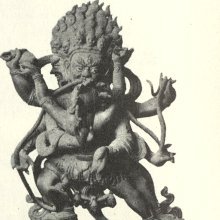Mahacakra, Mahācakrā, Mahācakra, Maha-cakra: 8 definitions
Introduction:
Mahacakra means something in Hinduism, Sanskrit. If you want to know the exact meaning, history, etymology or English translation of this term then check out the descriptions on this page. Add your comment or reference to a book if you want to contribute to this summary article.
Alternative spellings of this word include Mahachakra.
Images (photo gallery)
In Hinduism
Purana and Itihasa (epic history)
Source: Cologne Digital Sanskrit Dictionaries: The Purana IndexMahācakrā (महाचक्रा).—A river of Bhadrā country.*
- * Vāyu-purāṇa 43. 25.
Mahācakra (महाचक्र) refers to “great discuses” and represents one of the various weapons equipped by the Daityas in their war against Lalitā, according to the Brahmāṇḍa-purāṇa 4.22. Accordingly, “[...] thereupon, crores of Daityas producing reverberating chattering noise furiously prepared themselves (to fight) against Parameśvarī (Lalitā). [...] Crores of Daityas were fully equipped with coats of mail and had the following weapons and missiles in their hands [viz.: Mahācakras (great discuses)], and thousands of similar weapons and missiles very dreadful and capable of destroying living beings”.

The Purana (पुराण, purāṇas) refers to Sanskrit literature preserving ancient India’s vast cultural history, including historical legends, religious ceremonies, various arts and sciences. The eighteen mahapuranas total over 400,000 shlokas (metrical couplets) and date to at least several centuries BCE.
Shaktism (Shakta philosophy)
Source: Google Books: ManthanabhairavatantramMahācakra (महाचक्र) refers to the “great gathering”, according to the Manthānabhairavatantra, a vast sprawling work that belongs to a corpus of Tantric texts concerned with the worship of the goddess Kubjikā.—Accordingly, “May they, whom I have recollected and are satisfied, accept the vessel of the bali. All that is the Great Gathering [i.e., mahācakra] and (these are) the divine beings in the gathering. Present in gross and subtle bodies, they are incarnated in women and their forms are mantras”.

Shakta (शाक्त, śākta) or Shaktism (śāktism) represents a tradition of Hinduism where the Goddess (Devi) is revered and worshipped. Shakta literature includes a range of scriptures, including various Agamas and Tantras, although its roots may be traced back to the Vedas.
Shaivism (Shaiva philosophy)
Source: SOAS University of London: Protective Rites in the Netra TantraMahācakra (महाचक्र) refers to a “great wheel”, according to the Netratantra of Kṣemarāja: a Śaiva text from the 9th century in which Śiva (Bhairava) teaches Pārvatī topics such as metaphysics, cosmology, and soteriology.—Accordingly, [verse 6.28-32ab, while describing the śaśimaṇḍala]—“[The Mantrin] should write the name [of the afflicted] in the middle of a great wheel (mahācakra) [that] has sixteen petals. [He] adorns [the wheel] with the sixteen vowels, and encloses it with the mantra using the ādyanta pattern. The Mantrin should draw, as before, the jīva in the middle of saḥ, etc., protected at the end with the covering [i.e., the mantra]. The amṛteśa-mantra envelops [him] on all sides, at each syllable, in the middle of all petals, in the middle of the lunar orb. [...]”.

Shaiva (शैव, śaiva) or Shaivism (śaivism) represents a tradition of Hinduism worshiping Shiva as the supreme being. Closely related to Shaktism, Shaiva literature includes a range of scriptures, including Tantras, while the root of this tradition may be traced back to the ancient Vedas.
Languages of India and abroad
Sanskrit dictionary
Source: DDSA: The practical Sanskrit-English dictionaryMahācakra (महाचक्र).—the mystic circle in the शाक्त (śākta) ceremonial.
Derivable forms: mahācakram (महाचक्रम्).
Mahācakra is a Sanskrit compound consisting of the terms mahā and cakra (चक्र).
Source: Cologne Digital Sanskrit Dictionaries: Monier-Williams Sanskrit-English Dictionary1) Mahācakra (महाचक्र):—[=mahā-cakra] [from mahā > mah] n. a great wheel, a gr° discus, [Rāmatāpanīya-upaniṣad; Mahābhārata]
2) [v.s. ...] the mystic circle or assembly in the Śākta ceremonial, [Religious Thought and Life in India 196]
3) [v.s. ...] m. ‘having a gr° wh° or d°’, Name of a Dānava, [Harivaṃśa] ([varia lectio] -vaktra)
[Sanskrit to German]
Sanskrit, also spelled संस्कृतम् (saṃskṛtam), is an ancient language of India commonly seen as the grandmother of the Indo-European language family (even English!). Closely allied with Prakrit and Pali, Sanskrit is more exhaustive in both grammar and terms and has the most extensive collection of literature in the world, greatly surpassing its sister-languages Greek and Latin.
See also (Relevant definitions)
Starts with: Mahacakrapraveshajnanamudra, Mahacakravada, Mahacakravala, Mahacakravartin, Mahacakravartita.
Ends with: Paitamahacakra, Shaktimahacakra.
Full-text: Mahacakravada, Mahacakravala, Mahacakravartita, Mahacakrapraveshajnanamudra, Mahacakravartin, Sthulasharira, Sukshmasharira, Mantravigraha, Rakshoghna, Abhisara.
Relevant text
Search found 6 books and stories containing Mahacakra, Mahācakrā, Mahācakra, Maha-cakra, Mahā-cakra; (plurals include: Mahacakras, Mahācakrās, Mahācakras, cakras). You can also click to the full overview containing English textual excerpts. Below are direct links for the most relevant articles:
Chaitanya Bhagavata (by Bhumipati Dāsa)
Verse 2.19.190 < [Chapter 19 - The Lord’s Pastimes in Advaita’s House]
The gods of northern Buddhism (by Alice Getty)
Lalitopakhyana (Lalita Mahatmya) (by G.V. Tagare)
Chapter 22 - Durmada and Kuraṇḍa slain
Chapter 26 - Bhaṇḍāsura’s sons slain
Chapter 35 - The preparation of materials of worship in Mahāpadmāṭavī
Serpent Power (Kundalini-shakti), Introduction (by Arthur Avalon)
Chapter 7 - Theoretical Bases of this Yoga (Kuṇḍalinī and Laya-Yoga)
The Padma Purana (by N.A. Deshpande)
Chapter 18 - The greatness of Nandā-Prācī < [Section 1 - Sṛṣṭi-khaṇḍa (section on creation)]
Related products


